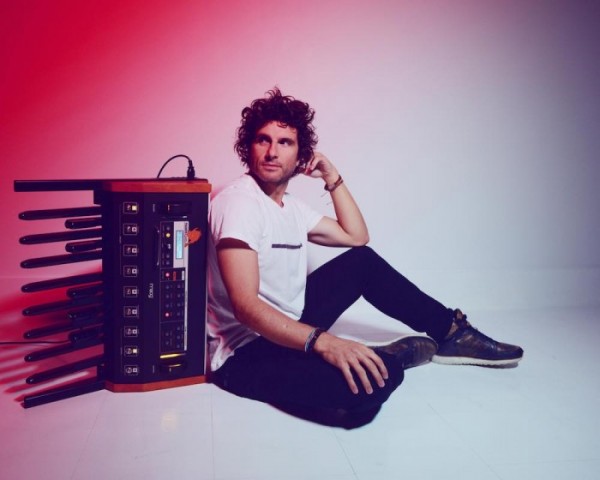Apr 2, 2024 12:59 PM
Saxophonist, Sonic Explorer Casey Benjamin Dies at 45
Casey Benjamin, the alto saxophonist, vocalist, keyboardist and producer who stamped his distinctive sounds on the…

Pianist Romain Collin learned to play synth bass before recording Tiny Lights.
(Photo: Shervin Lainez)Romain Collin often recalls an enduring maxim from Terence Blanchard: “All complicated things are created from an interaction among simple things.”
Those words locked in his mind, the pianist set out to create a mixed-media release reflective of a journey toward transcendence. In realizing Tiny Lights, Collin embarked on his own short, but vivid, journey toward self-discovery, issuing the record online in three separate installments representing a beginning, middle and end, before the physical album release.
“The story [describes] a process of self-growth in as fearless and committed a way as possible,” he said. “[Writing] music is the same.”
But Collin soon recognized the limits of his existing musical expression. “I discovered that the piano trio, as I had approached it so far, was not a setup that enabled me to express the sounds that I needed,” he said.
Knowing he wanted a trio recording with drums and guitar, Collin called guitarist Matthew Stevens and drummer Obed Calvaire. Contributions from the Prague Philharmonic Orchestra and composer Kazuma Jinnouchi helped texturize the narrative, while Collin attempted to master an instrument he was unfamiliar with: the Moog Taurus synth bass.
The bandleader composed the entire record—including a number of ostinatos shaping the musical narrative—without having ever touched the Taurus. “When I write ostinatos, the idea is never to be repetitive,” he said. “It’s the undercurrent, the driving force.” And Collin soon discovered the collateral impact of integrating a new sound and skill set into his performance. “When I first started playing the synth bass, it made me play the piano in a slightly more organic, less deliberate way,” he said.
What Collin found was freeing. He encountered relief from the pressure of his critical mind, and experienced renewed intention: “You have to be more accepting of what you play, because it’s almost like something that needed to be played.”
An accomplished film composer, Collin imbued Tiny Lights with layers of visual evocation and stimuli. “Every sound has a texture and a color in my brain,” he said. “In this project, I’ve allowed myself to pay attention to it more.”
For the record’s accompanying film series and recorded live performances that Collin posted to Instagram, he collaborated with Spain-based production house Neutrø. But back in the States, Collin met up with filmmaker Matthew Palmer, sharing with him the project idea for Tiny Lights. “He said, ‘Man, I really wanna put visuals to this,’” Collin recalled. “So, I sent him the music.”
Despite offering the signposts of a story, Collin relinquished creative control of the visual narrative to Palmer, who produced the video for “Tiny Lights That Move And Speak.”
“He came back to me and said, ‘This is what I’m seeing,’” Collin said, “and that’s exactly what I was seeing as well.”
The visual manifestation of Tiny Lights served another purpose for Collin, who came up with the MTV generation: recapturing mainstream audio-visual relationships that have been lost in the digital era. “Before MP3s and downloads, every musician was a multimedia artist,” he said. “They all had dope artwork—a booklet that you can lose yourself in, lyrics that were laid out graphically, pictures—it really gave the artists a chance to present a world bigger than just the music.”
For Tiny Lights, the allure of a mixed-media narrative unfolding in the age of insta-culture is what inspired Collin to release the album in three parts. “I’m hoping that that, in and of itself, tells a story,” he said. “If something inhabits you, day and night, how can you not allow it to transpire? You can’t escape that process. And you shouldn’t try.” DB

Benjamin possessed a fluid, round sound on the alto saxophone, and he was often most recognizable by the layers of electronic effects that he put onto the instrument.
Apr 2, 2024 12:59 PM
Casey Benjamin, the alto saxophonist, vocalist, keyboardist and producer who stamped his distinctive sounds on the…

“He’s constructing intelligent musical sentences that connect seamlessly, which is the most important part of linear playing,” Charles McPherson said of alto saxophonist Sonny Red.
Feb 27, 2024 1:40 PM
“I might not have felt this way 30 to 40 years ago, but I’ve reached a point where I can hear value in what people…

Albert “Tootie” Heath (1935–2024) followed in the tradition of drummer Kenny Clarke, his idol.
Apr 5, 2024 10:28 AM
Albert “Tootie” Heath, a drummer of impeccable taste and time who was the youngest of three jazz-legend brothers…

“Both of us are quite grounded in the craft, the tradition and the harmonic sense,” Rosenwinkel said of his experience playing with Allen. “Yet I felt we shared something mystical as well.”
Mar 12, 2024 11:42 AM
“There are a few musicians you hear where, as somebody once said, the molecules in the room change. Geri was one of…

Larry Goldings’ versatility keeps him in high demand as a leader, collaborator and sideman.
Feb 21, 2024 10:45 AM
Are you having any fun? Larry Goldings certainly is. Consider just two recent examples:
Scene 1: “If anyone had…